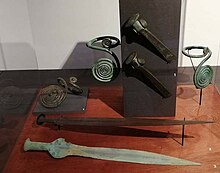
Back Вітэнбергская культура Byelorussian Cultura de Wietenberg Spanish Wietenberg-kultúra Hungarian Kultura Wietenberg Polish Витенбергская культура Russian Витенбершка култура Serbian
| Geographical range | Romania (Transylvania) |
|---|---|
| Period | Bronze Age |
| Dates | c. 2200 BC – 1500 BC |
| Preceded by | Coțofeni culture, Usatove culture |
| Followed by | Noua-Sabatinovka culture |


The Wietenberg culture was a Middle Bronze Age archeological culture in central Romania (Transylvania) that roughly dates to 2200–1600/1500 BCE. Representing a local variant of Usatove culture, it was contemporary with the Ottomány culture and Unetice culture and was replaced by the Noua culture. Its name was coined after the eponymic Wietenberg Hill near Sighișoara.
People of this culture traded with the Mycenaeans. Burial sites contain bronze battle axes and maces with stone heads. Pottery consists of amphorae with spiral and meandric ornament.
By 1964, about 200 settlements of this culture were discovered.